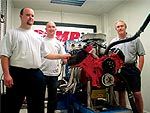
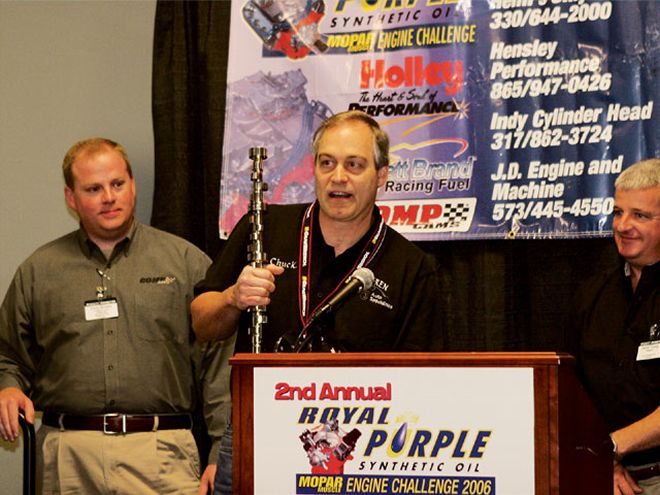 Lofgren Auto Specialties was awarded top honors in this year's engine challenge and received their trophy at the Performance Racing Industry Trade show in Orlando. This month, we go inside the Lofgren's engine, as well as Muscle Motors' second place entry, to see what makes these engines so potent.
Lofgren Auto Specialties was awarded top honors in this year's engine challenge and received their trophy at the Performance Racing Industry Trade show in Orlando. This month, we go inside the Lofgren's engine, as well as Muscle Motors' second place entry, to see what makes these engines so potent.
When we wrote the rules for our first engine challenge we wanted to ensure that this would be a competition between real world engines that would survive on the street. One-off combinations designed to make killer horsepower for a few dyno pulls had to be weeded out, so we set the standard at no less than six dyno pulls at an acceleration rate one-half what is normally used on an engine dyno. If any of these engines had a weakness, we planned to find it. The other criteria we considered while writing the rules was cost. We wanted to ensure that a high-budget shop couldn't just come in and kill everyone with peak horsepower, so we added the twist of factoring the retail cost of each engine's parts into the power the engine made for a composite score. We at Mopar Muscle are budget minded to the point of being called "cheap," so we wanted to be sure these engines stayed within a budget that our readers could afford. We must say, all the entrants in our competition exceeded our expectations. These shops made killer power on a budget that was way less than excessive. In fact, our engine challenge went over so well that a certain corporation seems to have adopted our template for their own engine competition. What can we say? Imitation is the finest form of flattery.
The best news is all the motors survived their time on the dyno, and some have already been installed and are cruising the streets. If you've been following our competition, you know the builders used a variety of tricks and techniques to give them an advantage, and that all started with the best engine building trick-a solid foundation of parts to work with. It wasn't too long ago that it took a huge bank account and lots of hand fabrication to tweak extra ponies from a Hemi project. Now the aftermarket is flush with support for the Hemi engine ,and, as a result of that competitive market, prices have become more reasonable. Cranks, blocks, pistons, rods, and cylinder heads are just a few of the many parts now available at prices that would have seemed ludicrously low even five years ago.
Two guys who took advantage of this abundance of aftermarket Hemi support are Chuck Lofgren of Lofgren Auto Specialties and Mike Ware of Muscle Motors. While these guys didn't make the most outright horsepower or torque in our competition, when the cost of their parts was factored into the power they made, they placed first and second in the challenge. Follow along as we look inside their engines to see what components and techniques were used in their builds.
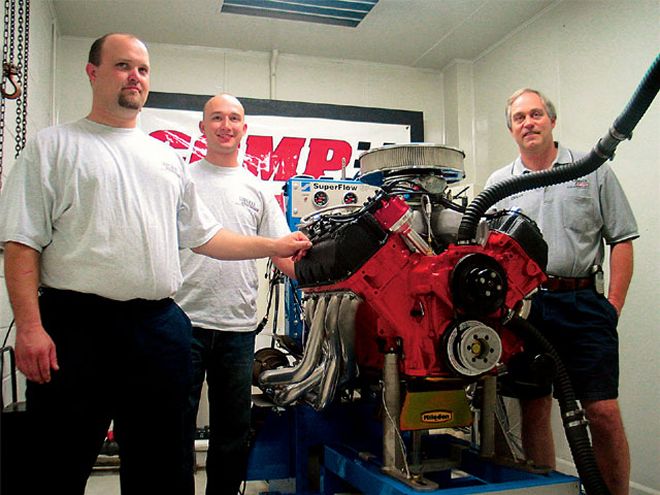 Chuck and his team proudly stand next to their entry in Comp's dyno cell after their engine screamed to more than 725 hp.
Chuck and his team proudly stand next to their entry in Comp's dyno cell after their engine screamed to more than 725 hp.
Lofgren Auto Specialties; Cedar, MN
Chuck Lofgren, owner of Lofgren Auto Specialties, is no stranger to the automotive world. Chuck's love of cars and racing began when he was working at a service station during the days when musclecars ruled the streets. Chuck is a graduate of not only an automotive mechanics program, but also automotive machining. He went on to open his own shop, which has been serving gearheads for the past 22 years. When Chuck isn't working in his shop, he's drag racing his wheelstanding, 9-second '70 Plymouth 'Cuda, a testament to his dedication to motorsports.
When asked about his winning combination in our Hemi engine challenge, Chuck states that planning and professionalism were his keys to making a good showing. He also admits his engine was based on a misinterpretation of the contest rules. He thought he had to use an off-the-shelf Mopar piston in his engine, which made things tricky. First, he had trouble finding a set of eight suitable pistons and, eventually, purchased single units from multiple Mopar Performance dealers who had one or two in stock. Next, though the contest rules stated that engines up to 500 ci were legal, the Mopar pistons would limit him to some 485 ci, making his engine the smallest in the contest at 15 inches shy of the limit. So how did the smallest motor win the contest? A list of tough and economical parts, combined with professional assembly techniques helped Lofgren lead our field of competitors.
All of the competitors utilized the same Mopar Performance block for their builds. Like most of the builders, the Lofgren team bored and bushed the block's lifter bores for valve timing accuracy. Remember that no matter how accurate a cam is ground, if the lifter bores are not true, valve timing will be affected. In addition to their use of Mopar Performance pistons-the domes of which were fly-cut to reduce compression-the Lofgren entry contained a stout rotating assembly, consisting of an Eagle 4.15-inch stroke crankshaft and Eagle H-beam rods measuring 6.86 inches center-to-center length. Combined with the .039-inch compressed thickness of the head gasket, the 84.45 cc of the dome, and 172cc chamber of the cylinder head, the Mopar pistons provided a compression ratio of 11.22:1. Custom Total Seal piston rings ensured the burnt gasses stayed in the combustion chamber where they belong. a Melling high-volume pump was combined with a Milodon pan and windage tray to supply oil to the engine, while keeping it away from the crankshaft. Federal Mogul semi-groove main and Clevite rod bearings kept everything spinning freely in this engine, and ARP fasteners were used to keep all the rotating assembly components in place. To complete the bottom end, an EPW timing set spun a Cam motion mechanical flat-tappet camshaft, which was installed in the block's journals with Durabond cam bearings bearing the load. The camshaft spec'd out at a gross lift of .642-inch intake and .620-inch exhaust, with duration at .050-inch lift at 273- and 276-degrees, respectively. Lobe center measured 110.1 degrees and the installed centerline of this cam was 107 degrees. Valve lash was set at the recommended .023 inch.
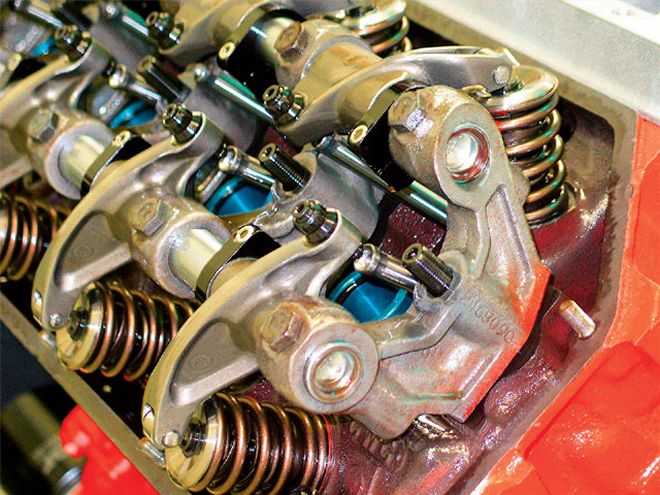 Lofgren was the only competitor to utilize factory cylinder heads. Not only did they support the winning combination, they made power well past the 7,000-rpm limit of our contest.
Lofgren was the only competitor to utilize factory cylinder heads. Not only did they support the winning combination, they made power well past the 7,000-rpm limit of our contest.
Choice of cylinder heads was definitely where the Lofgren team gained an advantage. By utilizing a set of cracked, factory '68 casting heads (that a customer refused to repair for his engine), costs were kept down, while substantial power was provided. The factory head is no slouch, and Chuck realized with some porting and proper valvetrain selection, this head would easily support the 485-inch motor at our 7,000-rpm limit. Port work was performed in-house, and Mopar Performance rockers, shafts, and stands were utilized to actuate the valves. Competition Cams provided the springs (PN 929), along with their valve locks and titanium retainers. Keeping in mind the budget factor of the contest, Chuck went with Mopar Performance 1.94-inch exhaust valves, but decided to show off another trick when it came to intake valve selection. Chuck claims to have gained a substantial amount of flow on the intake side by using custom Ferrea intake valves. These valves are a nailhead design, without the flow restricting material under the valve face that is found in the more conventional tulip-shape counterparts. Atop the heads, the Lofgren team chose Indy's 426-3 single-plane intake, which was match ported to the cylinder heads. A 1090-cfm Barry Grant King Demon took care of the fuel metering and performed flawlessly during the dyno pulls.
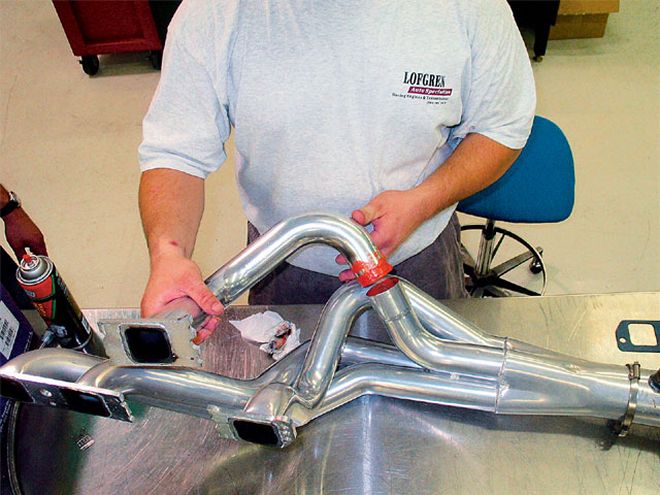 The Lofgren team definitely had the ability to think "outside the box." They were the only team who chose to seal the slip-tubes on the headers with silicone for more accurate air-fuel readings.
The Lofgren team definitely had the ability to think "outside the box." They were the only team who chose to seal the slip-tubes on the headers with silicone for more accurate air-fuel readings.
In addition to bringing a potent Hemi to our challenge, the Lofgren team impressed us with their professionalism. These guys were a fine-tuned machine making well thought out tuning decisions before applying them in the dyno cell. They were also the only team to bring a weather station and to run an air cleaner base on their engine, noticing the turbulence the dyno cells fans created. what more can we say, except congratulations.
Muscle Motors; Lansing, MI
Muscle Motors in Lansing, Michigan, is a name synonymous with high-performance Mopar engines. Mike Ware and his team have been supporting both Mopar racers and street enthusiasts with professional engine builds and machine shop services for years and can build as much power as your budget can afford.
When it came to stuffing his Mopar Performance block full of go-fast goodies, Mike took the economical approach. Knowing his engine would make acceptable power without using extremely high-end parts, Mike's math told him if he could keep costs low, nobody could touch his composite score, no matter how much power they made. His calculations must have been close because even with a fifth place ranking when factoring power and torque alone, the low cost of his build catapulted him to second when cost was factored.
We applaud Mike for bringing an engine that epitomized the rules we wrote for the contest-good power at an affordable cost. It is for that reason the Muscle Motors entry has the most economical retail price at $17,150.
Inside his Mopar Performance block, Mike stayed away from pricey, one-off pieces and relied on quality, off-the-shelf parts and proven machining and assembly techniques to make his entry competitive. A Muscle Motors Private Label 4.15-inch stroke crankshaft, matched with their own Private Label rods, were combined with Diamond pistons to form the rotating assembly of this motor, which checked in right at our limit of 500 ci. everything was balanced in-house to ensure the longevity of this engine. Like most of our competitors, Mike combined a Melling oil pump with a Milodon pan, pick up, and windage tray to complete his oiling system. Camshaft selection is vital to any engine build, and Mike takes it very seriously. Not liking what he saw in the off-the-shelf catalogs, he chose to have Comp Cams custom grind a camshaft to his specifications. While this sounds pricey, it's actually not. Comp's custom-grind cams usually retail for about the same price as their stocked items and, in our experience, they can usually have the cam ground and delivered in a few days. We do, however, advise that you use caution if you're toying with the idea of your own custom cam grind. The engineers at Comp spend countless hours designing and testing their cam profiles, so it's hard to beat their research on your own. Mike was keeping the specifics on his cam somewhat secret, but rumor has it that lift was in the mid-.600 range, with duration at .050-inch lift around 270 degrees.
Atop the Muscle Motors short-block, Mike opted for Mopar Performance aluminum cylinder heads. Knowing the thermal efficiency of steel heads would give him an extra pony or two, Mike again did the math and discovered the aluminum units actually retail for less money-an advantage that would outweigh any performance gain offered by the steel units. The cylinder heads were given a thorough port job in house before being assembled, using valves from Racing Engine Valves (REV). Comp Cam's valvesprings (PN 930) kept the valvetrain stable to the 7,000-rpm limit of our contest, and everything was kept in place with Comp retainers and locks. By using Muscle Motors own rocker stands (PN 426RS), combined with Indy Cylinder Head's 426-27 rockers to actuate the valvetrain, costs were again kept in check. An Indy 426-2 single-plane intake, topped with an 1190-cfm Barry Grant King Demon carburetor, took care of the induction duties and provided plenty of flow for this 500-inch Hemi. Though he placed well in our contest, it was not without struggles. While hurriedly setting the ignition timing of his motor after a last minute distributor swap, the dial on the timing light was inadvertently spun, resulting in ambiguous ignition timing readings. Mike recognized this problem just prior to his final judged dyno pull and made the correction in time to post his best number in the last pull. While this is a testament to Mike's ability to work under pressure, we're sure he could have tweaked a little more from his engine had he not had difficulties.
We appreciate Mike's efforts in our competition. his engine made good power, but what impressed us even more was the concentration on the economics of the contest. Each engine builder wanted to be the big dog on the block and impress us with high-horsepower numbers, so it took some restraint for Mike to resist that temptation. His research and efforts to keep costs down definitely helped him to a second place finish in the competition. We congratulate Mike and are happy to have him in the Mopar community supplying gearheads with affordable power for their street or strip vehicles.
Next month we'll feature two more of the Hemis in our challenge, so stay tuned.